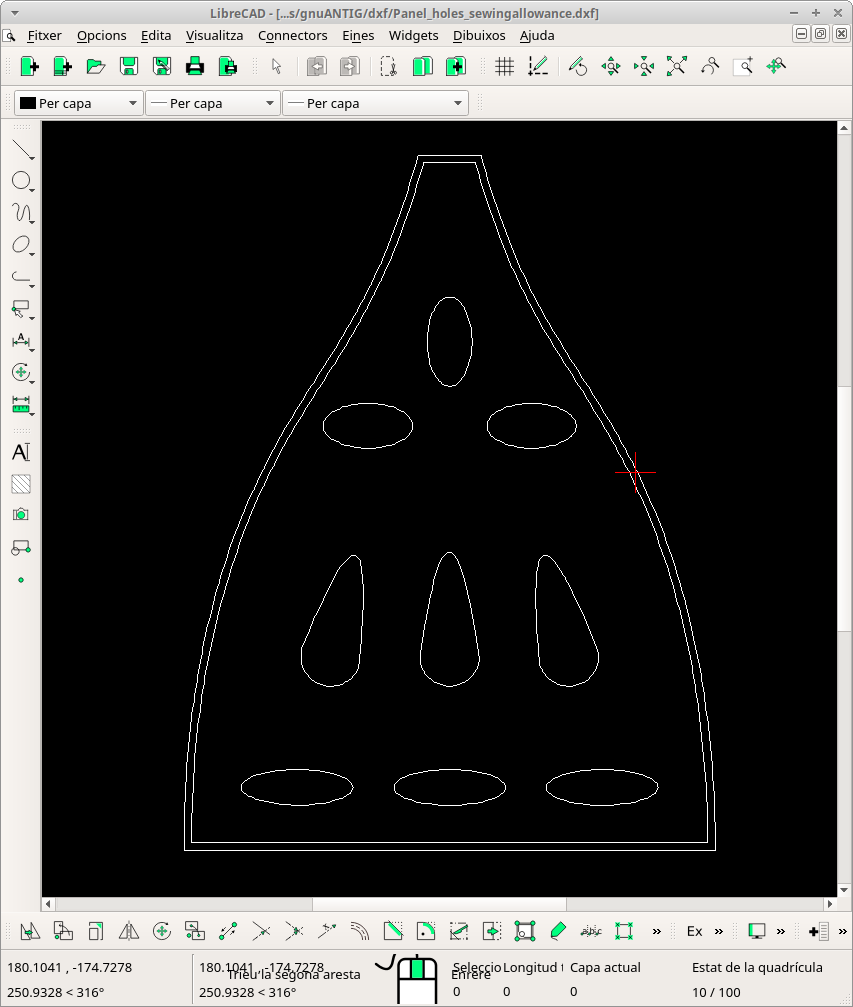
[en] [de] [fr]
GNU AntiG
aka "Swiss-cheese-chute"

Figure 1. GNU AntiG, first test
1. DESCRIPTION
GNU AntiG aka "Swiss-cheese-chute". Designed and built by Jeremy Paxson (Germany), in September 2022. The design has been made using the small program LEparachute v0.2.
The model presented here is the second prototype, after experimenting
with a first prototype that was not stable enough, nor big enough. This
second prototype is stable and fulfills the expected objectives.
Stability is achieved with multiple openings in the dome. Hence the
name "Swiss-cheese-chute"
:) The parachute is easily retractable in flight (experiments performed
correctly). Total weight 176 g incl everything. Projected surface 2.43
m2. A much needed safety complement for pilots flying high performance
wings!
Jeremy summarizes for us the usefulness and importance of the anti-G parachute:
"It is especially to fly spirals, with a much higher sink rate. With
modern gliders, especially 2 liners, there are no other methods to come
down faster, because they don't do Ears or B-stall. But spiraling is
really hard, because of the speed and dynamic of these gliders you
rotate very fast, have a lot G's, but don't sink very much.
4 weeks ago I was stuck in such a
situation in a big thermal, closed airspace above and around.
Thermal was 3m/s up, spiral was 4m/s down, high G's, did that for 10
min with 1m/s sink, not good for the glider and not good for me. So
that's where I decided I need this break chute. In normal level flight
it breaks, but not much, as Speed is slow, but as Drag increases in
square by the rising speed, it gets more and more effective the fast
you go."
2. DATA FILES AND PLANS
"These
are the files and output data of the Spiral Break Parachute. I added a
dxf with only one panel (as they are the same anyway) included sewing
allowance and the holes. I also added a splitted version of one panel,
its for laser cutting, it already has 10 mm sewing allowance around the
outer border of the original shape.
The line length I took exactly from
the output file. Only addition is a connection line of about 150 cm
between main anchor point of all lines and the Harness carabiner. The
central Apex line has to be prolonged accordingly to this
connectionline to have a kill line (pull the center line approximately
30 cm in flight direction, that will let the chute collapse
completely). Also I need to install a swirel somewhere, to prevent the
lines from getting twisted due to rotation of the chute.
I used an old rescue parachute, because it's the ideal material and
easy and cheap to get on the second hand paraglider market. Also it's
somehow a "second life" Thing to reuse material if possible."
PARACHUTE AND PARASAIL DESIGN PROGRAM
Laboratori d'envol
Version: 0.20
Brand: Laboratori
d'envol
Model:
SwissCheeseChute
N gores: 8
Main radius (m): 0.88
Dome height (m): 1.82
Meridian lenght (m): 1.33
Surface sail (m2): 3.38
Surface projection (m2): 2.43
Lines (cm):
Line 1 202.16
Line 2 202.16
Line 3 202.16
Line 4 202.16
Line 5 202.16
Line 6 202.16
Line 7 202.16
Line 8 202.16
Central Line 198.00
Central apex lines 16.87
LEparachute input and output files: data.txt lepc-out.txt lines.txt parachute.dxf lepc-3d.dxf
Construction dxf's: Panel_holes_sewingallowance.dxf PanelSplitted_lower_part.dxf PanelSplitted_upper_part.dxf mosaic.dxf
Panel in PDF ready to print in A4 sheets: mosaic.pdf
Printer calibration: mosaic-calibration.pdf

Figure 2. 8-gores parachute (parachute.dxf)

Figure 3. Data file interpretation of parameters a,b,c,ap,Ar,Line height, defining the dome (parachute.dxf)

Figure 4. Complete gore including seam allowance and holes. Make x 8. File Panel_holes_sewingallowance.dxf

Figure 5. Panel in PDF ready to print in A4 sheets: mosaic.pdf
Printer calibration: mosaic-calibration.pdf
2. MORE PHOTOS

Figure 6. GNU AntiG. Now understood why "Swiss-cheese-chute"? :)
 Figure 7. GNU AntiG flight test
Figure 7. GNU AntiG flight test
Many thanks to Jeremy Paxson for sharing his design and plans, which
are the result of important theoretical and experimental work.
A gift to the worldwide community of paraglider designers and builders.
LAB NOTE: Build
a paraglider at home is a
very complicated task (even simple
skin), and requires many
hours of work. Previous experience is required, and very inventive.
As always remember that:
The free flight implies risks
that can only be known and they can be controled with a suitable formation on the part of a recognized school.
Not test wings without knowing their functioning. The
construction and test of experimental wings without certifying requires
deep knowledge of what is being made.








